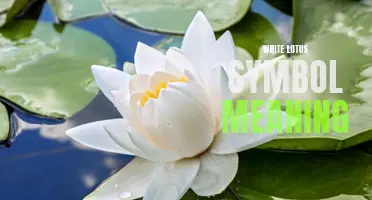
Goddess symbols have been used throughout history to represent various aspects of feminine energy and power. These symbols often embody qualities such as love, fertility, wisdom, and strength. From ancient mythological figures to modern interpretations, goddess symbols continue to inspire and empower women around the world. Whether it's the nurturing nature of Demeter or the sensual allure of Aphrodite, goddess symbols serve as reminders of the divine feminine energy that exists within all of us. Join us as we delve into the rich symbolism and hidden meanings behind these powerful symbols of goddess energy.
What You'll Learn
- What are some common symbols associated with goddesses and their meanings?
- How have goddess symbols and their meanings evolved throughout history and across different cultures?
- What role do goddess symbols play in modern spiritual and religious practices?
- Are there any specific goddess symbols and meanings that are particularly important or widely recognized in certain cultures or belief systems?
- How can understanding goddess symbols and their meanings enhance our understanding and appreciation of ancient mythologies and the divine feminine?

What are some common symbols associated with goddesses and their meanings?
Goddesses have been revered and worshipped in various cultures throughout history. They represent divine femininity, and each goddess often has her own unique symbols associated with her. These symbols can be seen in art, mythology, and religious rituals, and they often carry deep meanings and significance. Here are some common symbols associated with goddesses and what they represent.
- Crescent Moon: One of the most common symbols associated with goddesses is the crescent moon. It is often depicted as a thin, curved shape resembling a crescent. The crescent moon represents feminine power and the phases of the moon. It symbolizes the cyclical nature of life, death, and rebirth, as well as intuition and the mysteries of the unknown.
- Lotus Flower: The lotus flower is a sacred symbol in many Eastern cultures and often associated with goddesses such as Lakshmi, Saraswati, and Quan Yin. The lotus flower is known to rise above muddy waters and grow into a beautiful blossom, representing spiritual enlightenment, purity, and beauty. It symbolizes the goddess's ability to transcend challenges and find inner peace.
- Serpent: In many ancient cultures, the serpent is associated with goddesses and represents wisdom, transformation, and healing. The serpent shedding its skin symbolizes rebirth and renewal, while its transformative nature represents the goddess's ability to bring about change and transformation.
- Dove: The dove is a symbol of peace, love, and purity and is often associated with goddesses of love and fertility. In Greek mythology, Aphrodite is often depicted with doves, symbolizing her gentle and peaceful nature. Doves are also associated with the Virgin Mary, representing her purity and innocence.
- Owl: Owls are often associated with wisdom and knowledge and are considered sacred to many goddesses, such as Athena in Greek mythology. The owl's ability to see in the dark represents the goddess's ability to see what others cannot and her deep understanding of the world. Owls are also associated with prophecy and intuition.
- Sun: The sun is a powerful symbol of light, warmth, and life-giving energy. In many cultures, the sun is associated with goddesses of fertility, such as the Egyptian goddess Isis and the Aztec goddess Tonantzin. The sun represents the goddess's life-giving and nurturing qualities, as well as her power to bring abundance and growth.
- Earth: The earth is often associated with goddesses of nature and fertility. It represents the goddess's connectedness to the natural world and her nurturing and life-giving qualities. The earth symbolizes abundance, growth, and the cycle of life.
These symbols are just a few examples of the many symbols associated with goddesses. Each goddess has her own unique symbols and meanings, and they often vary across different cultures and traditions. These symbols not only hold aesthetic value but also carry deep spiritual and symbolic significance, offering insights into the goddess's characteristics, powers, and influence.
Decoding the Hidden Language: Exploring the Science Symbols and Their Meanings
You may want to see also

How have goddess symbols and their meanings evolved throughout history and across different cultures?
Goddess symbols have played a significant role in human civilizations for thousands of years. They have been used to represent the divine feminine, fertility, and the power of women. Throughout history, these symbols and their meanings have evolved and changed across different cultures, reflecting the beliefs and values of the societies in which they originated.
In ancient cultures, goddess symbols often represented the different aspects of the natural world. For example, the Egyptian goddess Isis was associated with fertility and motherhood. Her symbol, the ankh, was a hieroglyphic that represented life. In this context, the symbol of the goddess was used to invoke her protective and nurturing qualities.
In Greek mythology, the goddess Athena was revered as the goddess of wisdom, justice, and war. Her symbol, the owl, represented wisdom and was often associated with the goddess herself. The owl was believed to be a symbol of protection and insight, making it a powerful and meaningful symbol in ancient Greek culture.
Similarly, in Hindu mythology, the goddess Lakshmi symbolizes wealth, prosperity, and abundance. Her symbol, the lotus flower, represents purity and divine beauty. The lotus is also associated with fertility and spiritual enlightenment, making it a sacred symbol in Hinduism.
As civilization progressed and cultures evolved, the meanings of these goddess symbols also evolved. In some cases, goddess symbols were co-opted or adapted by different cultures to fit their own beliefs and practices. For example, the Christian Virgin Mary is often depicted with a halo, which was originally a symbol of the goddess Athena in ancient Greece.
In modern times, goddess symbols have taken on new meanings and have been reclaimed by feminist and spiritual movements. These symbols are often used to celebrate the power and strength of women and to challenge traditional gender roles. The triple moon symbol, for example, represents the three phases of the moon and is often associated with the goddess in her maiden, mother, and crone aspects. This symbol has become a powerful representation of female empowerment and the cyclical nature of life.
In conclusion, goddess symbols and their meanings have evolved throughout history and across different cultures. These symbols have represented various aspects of the natural world, fertility, and the power of women. Over time, the meanings of these symbols have adapted and changed, reflecting the beliefs and values of the societies in which they originated. Today, goddess symbols continue to hold significance for many people, representing empowerment, spirituality, and the divine feminine.
The Powerful Symbolism and Meaning Behind the Month of May
You may want to see also

What role do goddess symbols play in modern spiritual and religious practices?
Goddess symbols have long held significance in spiritual and religious practices throughout history. These symbols are representations of the divine feminine and are often used to honor and connect with the energies associated with the goddess.
In modern spiritual and religious practices, goddess symbols continue to play a vital role. They serve as visual reminders and focal points for meditation and ritual. These symbols can be found in various forms, including jewelry, artwork, and altars. Each symbol carries its own meaning and can be used to invoke different aspects of the goddess.
One commonly used goddess symbol is the triple moon symbol, also known as the triple goddess symbol. This symbol consists of three interlocking crescent moons, each representing a different phase of the moon: waxing, full, and waning. It is associated with the Triple Goddess, a deity often revered in Wiccan and neopagan traditions. This symbol is used to honor the cycles of nature and the phases of a woman's life, representing aspects such as maidenhood, motherhood, and cronehood.
Another widely recognized goddess symbol is the pentacle. The pentacle is a five-pointed star enclosed within a circle. It is often associated with the elements (earth, air, fire, water, and spirit) and is used for protection and invoking the energy of the goddess. The pentacle can be found in various spiritual practices, including neopaganism, witchcraft, and ceremonial magic.
The lotus flower is another powerful goddess symbol. It is associated with various goddesses, such as Lakshmi in Hinduism and Isis in ancient Egyptian mythology. The lotus symbolizes purity, enlightenment, and the blossoming of spiritual potential. It is often depicted in artwork and used in meditation practices to connect with the divine feminine energy.
In addition to these specific symbols, various other goddess symbols are used in modern spiritual and religious practices. These symbols can represent different aspects of the goddess, such as love, fertility, wisdom, and empowerment. They serve as reminders of the divine feminine qualities that can be cultivated within oneself and in the world.
The use of goddess symbols in modern spiritual and religious practices allows individuals to connect with the feminine energy within and around them. These symbols provide a visual representation of the divine feminine, serving as a reminder of the sacredness and power of the feminine aspect of spirituality. They also serve as tools for meditation, ritual, and manifestation, helping individuals align with the energies of the goddess and invoke her blessings in their lives.
Overall, goddess symbols continue to hold significance in modern spiritual and religious practices. They serve as visual reminders of the divine feminine and are used to honor and connect with the energies associated with the goddess. Whether through jewelry, artwork, or altars, these symbols play a crucial role in invoking the power of the goddess and cultivating a deeper connection with the divine feminine.
Unveiling the Enigmatic Meaning of the Greek Key Symbol
You may want to see also

Are there any specific goddess symbols and meanings that are particularly important or widely recognized in certain cultures or belief systems?
Goddess symbols and their meanings vary across different cultures and belief systems. Throughout history, goddesses have been worshipped in various forms, each with distinctive symbols that carry significant meanings. These symbols often represent specific qualities or aspects of the goddesses' powers and attributes. Here are a few examples of widely recognized goddess symbols and their meanings in different cultures.
One of the most widely recognized goddess symbols is the symbol of the triple goddess, which represents the maiden, mother, and crone. This symbol is associated with the cycles of life, the phases of the moon, and the different stages of a woman's life. In ancient civilizations such as the Celtic and Wiccan traditions, the triple goddess symbolizes the three aspects of the feminine divine.
In Greek mythology, the goddess Athena is often depicted with an owl, which is her sacred animal. The owl is a symbol of wisdom, knowledge, and intuition. Athena, as the goddess of wisdom, is known for her intellect and strategic thinking, which is represented by the owl.
In Egyptian mythology, the goddess Isis is often depicted with wings spread wide. The wings symbolize her role as a protector and her ability to guide souls to the afterlife. Isis is considered the goddess of motherhood, magic, and fertility, and the spread wings signify her nurturing and protective qualities.
The Hindu goddess Lakshmi is often depicted with lotus flowers. The lotus flower represents spiritual enlightenment, purity, and beauty. Lakshmi is the goddess of wealth, prosperity, and abundance, and the lotus symbolizes her blessings and abundance in all aspects of life.
In Norse mythology, the goddess Freyja is associated with the cat as her sacred animal. The cat represents feminine strength, sensuality, and independence. Freyja, as a goddess of love, beauty, and fertility, embodies these qualities, and the cat is a symbol of her power and grace.
In Native American cultures, the Kokopelli symbolizes the fertility deity. Kokopelli is often depicted as a humpbacked flute player and is considered a symbol of fertility, agriculture, and abundance. The flute represents the music and joy that Kokopelli brings, and his presence is believed to bring good fortune and prosperity.
These are just a few examples of goddess symbols and their meanings in different cultures and belief systems. Each symbol carries cultural significance and represents specific qualities or aspects of the respective goddesses. These symbols often serve as reminders of the power and attributes associated with the goddesses and can be used in various rituals and practices to connect with their energies and invoke their blessings.
Exploring the Deep Symbolism of the Leaf: What Does it Really Signify?
You may want to see also

How can understanding goddess symbols and their meanings enhance our understanding and appreciation of ancient mythologies and the divine feminine?
Goddess symbols are powerful representations of the divine feminine that have been used for centuries to portray various aspects of femininity, fertility, and wisdom. These symbols provide valuable insight into ancient mythologies and can enhance our understanding and appreciation of the diverse roles that goddesses played in different cultures.
One of the most well-known goddess symbols is the crescent moon, which is often associated with goddesses such as Artemis and Selene. The crescent moon represents the cyclical nature of the moon and is a symbol of femininity, intuition, and fertility. Understanding this symbolism helps us appreciate the significance of these goddesses as protectors of women and guardians of nature's cycles.
Another important goddess symbol is the serpent, often associated with goddesses like Athena and Medusa. The serpent symbolizes wisdom, transformation, and healing. In ancient mythologies, the serpent was seen as a source of knowledge and a guide to the underworld. By understanding the symbolism of the serpent, we gain a deeper understanding of the complex roles of these goddesses as both protectors and bringers of wisdom.
The lotus flower is yet another powerful symbol associated with goddesses such as Lakshmi and Isis. The lotus represents purity, beauty, and spiritual enlightenment. It is often depicted as a flower that emerges from muddy waters, symbolizing the potential for growth and transformation. By understanding the symbolism of the lotus, we can better grasp the role of these goddesses as sources of nourishment and spiritual guidance.
By examining and understanding these goddess symbols and their meanings, we can also gain insight into the significance of the divine feminine in ancient mythologies. The goddesses of ancient cultures were often depicted as powerful and multi-faceted beings who embodied various aspects of femininity. They were not limited to a single role but played multiple roles as protectors, creators, healers, and guides.
For example, the Greek goddess Athena was not just a warrior goddess but also a source of wisdom and inspiration. Similarly, the Hindu goddess Durga symbolized both strength and compassion. By understanding the symbolism associated with these goddesses, we can appreciate the complexity and depth of their roles in ancient mythologies.
Moreover, understanding goddess symbols helps us recognize the universal aspects of the divine feminine across different cultures. While the specific goddesses and their stories may differ, the underlying symbols and meanings often overlap. This realization can foster a deeper appreciation for the interconnectedness of different mythologies and the shared spiritual aspects of the divine feminine.
In conclusion, understanding goddess symbols and their meanings can greatly enhance our understanding and appreciation of ancient mythologies and the divine feminine. These symbols provide valuable insights into the roles and attributes of goddesses in different cultures. They also highlight the universal aspects of the divine feminine and its significance in the spiritual traditions of various civilizations. By delving into the symbolism of goddesses, we can gain a deeper appreciation for the richness and complexity of ancient mythologies and their enduring relevance in our modern world.
The Intriguing Symbolism of the Crystal Ball: Unlocking Hidden Meanings
You may want to see also
Frequently asked questions
The goddess symbol of the moon holds great significance in many cultures and religions. It represents femininity, intuition, and the ever-changing nature of life. The moon is often associated with goddesses, such as Artemis, Diana, and Selene, who are believed to embody its mystical powers. The crescent moon symbol, in particular, is commonly associated with the goddess symbol, as it represents the waxing and waning phases of the moon and the cyclical nature of life and death.
The goddess symbol of the sun is often associated with vitality, strength, and enlightenment. The sun is seen as a life-giving force, providing warmth, light, and energy to sustain all living beings on Earth. In various mythologies, goddesses such as Amaterasu in Japanese culture, Surya in Hinduism, and Hathor in ancient Egyptian religion are depicted as solar deities, embodying the power and radiance of the sun. The sun goddess symbol is often portrayed as a circle with rays emanating from it, symbolizing the sun's radiant energy.
The triple goddess symbol represents the three stages of a woman's life: maiden, mother, and crone. It embodies the cycles of creation, growth, and transformation. The maiden phase represents youth, innocence, and new beginnings; the mother phase represents fertility, nurturing, and the creative energy of giving birth; and the crone phase represents wisdom, experience, and the journey towards spiritual enlightenment. The triple goddess symbol is often depicted as three interconnected circles or a figure of a woman with three distinct phases.
The pentacle is a five-pointed star within a circle and is commonly associated with the goddess symbol in many pagan and Wiccan traditions. It represents the five elements – earth, air, fire, water, and spirit – and their interconnectedness in the natural world. The goddess symbol of the pentacle signifies balance, harmony, and the power of manifestation. It is often used for protection, as it is believed to ward off negative energies and promote spiritual growth.







